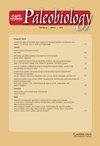沉积包裹的压力-温度成熟实验阐明了成岩作用对以黑色素为基础的化石颜色的影响及其古生物学意义
IF 2.7
2区 地球科学
Q2 BIODIVERSITY CONSERVATION
引用次数: 1
摘要
黑色素是现代脊椎动物被皮颜色和图案的核心,它决定着生态和行为策略,如隐化、警告和社会性选择。在过去的十年里,黑色素已经成为一种有价值的工具,用于预测保存完好的化石羽毛的颜色,以及随后对灭绝已久的恐龙和鸟类的古生物学假设进行测试。然而,关于黑色素的稳定性、黑色素化学的成岩改变,以及它们对“古颜色重建”的影响,还有很多有待研究。压力-温度成熟实验与现代羽毛提供了一种方法来检查这些主题,但大多是在封闭系统胶囊或开放系统铝箔进行。这两种方法都有操作局限性,并且没有考虑多孔沉积物基质在自然石化过程中对热不稳定化学基团与稳定化学基团的过滤作用。我们使用沉积物包裹的成熟来解决这个问题,并证明黑色素的有机保存复制与压缩化石高度相似。我们的实验,结合飞行时间二次离子质谱分析,显示了可预测的含N/ s分子的挥发,以及随着温度升高而增加的黑色素交联。我们还认为,在较高的温度下,真黑素比异黑素更稳定,这就解释了为什么真黑素的颜色(黑色、深棕色、彩虹色)比异黑素的颜色(红棕色)在化石中保存得更好。此外,我们提出蛋白质在类似于自然基质的选择性开放系统中比形成n -杂环更优先地进行水解。因此,我们得出结论,黑色素色素而非成岩改变的蛋白质残余物是促进羽毛等软组织石化的关键参与者。本文章由计算机程序翻译,如有差异,请以英文原文为准。
Sediment-encased pressure–temperature maturation experiments elucidate the impact of diagenesis on melanin-based fossil color and its paleobiological implications
Melanin pigments are central to colors and patterns in modern vertebrate integuments, which inform upon ecological and behavioral strategies like crypsis, aposematism, and sociosexual selection. Over the last decade, melanin has emerged as a valuable tool for predicting color in exceptionally preserved fossil feathers and subsequent testing of paleobiological hypotheses in long-extinct dinosaurs and birds. Yet much remains to be learned about melanin stability, diagenetic alterations to melanin chemistry, and their implications for “paleocolor reconstruction.” Pressure–temperature maturation experiments with modern feathers offer a way to examine these topics but have mostly been conducted in closed-system capsules or open-system aluminum foil. Both methods have operational limitations and do not consider the filtering effect of porous sediment matrices on thermally labile chemical groups versus stable ones during natural fossilization. We use sediment-encased maturation to resolve this issue and demonstrate replication of organic preservation of melanin highly comparable to compression fossils. Our experiments, coupled with time-of-flight secondary ion mass spectrometry, show predictable volatilization of N/S-bearing molecules and increased melanin cross-linking with elevated temperatures. We also suggest that eumelanin is more stable compared with pheomelanin at higher temperatures, explaining why eumelanic colors (black, dark brown, iridescent) are better preserved in fossils than pheomelanic ones (reddish brown). Furthermore, we propose that proteins preferentially undergo hydrolysis more so than forming N-heterocycles in selectively open systems analogous to natural matrices. Thus, we conclude that melanin pigments and not diagenetically altered protein remnants are the key players in promoting fossilization of soft tissues like feathers.
求助全文
通过发布文献求助,成功后即可免费获取论文全文。
去求助
来源期刊

Paleobiology
地学-古生物学
CiteScore
5.30
自引率
3.70%
发文量
38
审稿时长
>12 weeks
期刊介绍:
Paleobiology publishes original contributions of any length (but normally 10-50 manuscript pages) dealing with any aspect of biological paleontology. Emphasis is placed on biological or paleobiological processes and patterns, including macroevolution, extinction, diversification, speciation, functional morphology, bio-geography, phylogeny, paleoecology, molecular paleontology, taphonomy, natural selection and patterns of variation, abundance, and distribution in space and time, among others. Taxonomic papers are welcome if they have significant and broad applications. Papers concerning research on recent organisms and systems are appropriate if they are of particular interest to paleontologists. Papers should typically interest readers from more than one specialty. Proposals for symposium volumes should be discussed in advance with the editors.
 求助内容:
求助内容: 应助结果提醒方式:
应助结果提醒方式:


